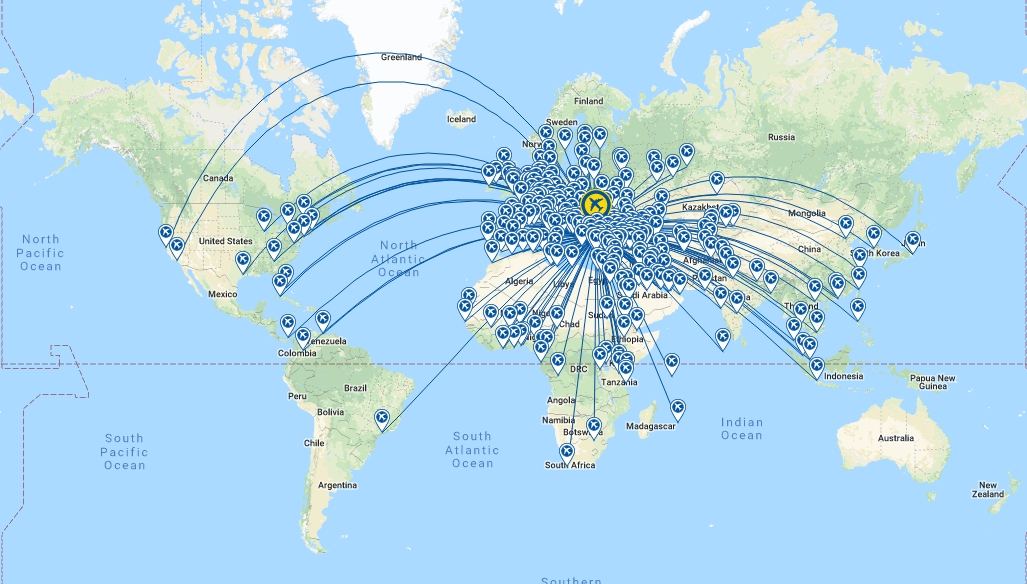Summary:
- The first phase of Istanbul's new airport is on track to open at the end of Oct-2018;
- ORAT procedures are in place for the world's biggest ever changeover between airports;
- They have to be prepared as history shows that airports have had some remarkable failures at this stage;
- Meanwhile, there is a high death rate amongst workers, triggering potential safety concerns for passengers.
The airport - one of the world's largest - is set to open on 29-Oct-2018, involving what is claimed to be the world's largest airport transfer, of services and appropriate infrastructure from the existing Atatürk Airport. Not only in terms of passenger numbers, but in geography. The two airports are over 45 km apart.
Operational Readiness and Airport Transfer (ORAT) procedures have been ongoing for some time and three trials involving 9,000 people and 10 actual flight arrivals and departures will take place during the next month. The ORAT project has involved eight consultants from Copenhagen and Incheon Airports, a team of 60 people and 100 operational staff, all of whom have aviation experience in fields such as airports, airlines and handling.
Such trials are essential. It may be a dim and distant memory now but when London Heathrow Airport's Terminal 5 opened in Mar-2008 it can only be described as a shambolic exercise, particularly in the area of baggage handling, where uncollected bags built up into mountains, despite claims systems had been "tested to destruction". Later it became apparent that the design of the ceiling lighting system meant it was almost impossible to change the bulbs without abseiling between them.
Heathrow T5 was also one of the first terminals - and remember this was 10 years ago - where it became apparent that computer operations (again mainly in baggage handling) had become too quick for the human operators to keep up with, or at least that was the claim. A decade on, with all the talk of digitisation, biometrics, algorithms and artificial intelligence it is more essential than ever to ensure there is co-ordination between machines and human operators. Of course, one day there will be no human operators but that isn't the case just yet.
The airport's history dates back to as recently as 2012 when the Ministry of Transport and Communication announced that plans for a four-stage, USD36 billion new airport in Istanbul would be put out to tender before the end of the year. At the same time plans to develop an airport city complex on the 690ha land plot surrounding the facility were announced. The airport is located in Arnavutköy, a district in the northern part of the city's European side.
MAP - The existing Istanbul Atatürk Airport, which the new facility will replace, is presently linked to 275 passenger and 52 cargo destinations Source: CAPA - Centre for Aviation and OAG (data: w/c 17-Sep-2018)
Source: CAPA - Centre for Aviation and OAG (data: w/c 17-Sep-2018)
Phase I of the new airport will comprise three runways and three taxiways, with a 90 million passenger capacity, rising to 150 million passengers per annum once fully operational in 2028. The airport is being built on a build-operate-transfer model over 25 years and İGA-İstanbul New Airport is a consortium of five Turkish firms which does not include TAV Airports, the operator of Atatürk Airport, which has since turned its attention towards the possibility of acquiring a stake in the Sabiha Gökçen International Airport on the eastern (Asian) side of the city.
After it has opened IGA will add two runways, a second terminal and auxiliary support facilities over several phases in order to increase capacity to 120 million passengers per annum by 2022, at which stage it would be the busiest airport in Europe by some margin. A new satellite terminal and additional runway is expected to be commissioned in the airport's fourth phase of development in order to reach ultimate capacity of 200 million ppa.
The speed at which the first phase has been built matches that of other mega new airport projects in China and Mexico. Between Sep-2017 and May-2018 the airport went from 64.5% complete to 88.5% complete. The entire project from concept to first phase opening will have taken six years; one tenth of the time it took to make a decision on a single runway in London.
But can speed equate to dangerous haste? In the last week there have been employee protests about work related deaths and accidents at the airport construction site, as well as poor living and working conditions. According to the Ministry of Transport, 35,000 employees work on the site, 35 of whom have died from work related accidents (0.1%). That figure is high. According to UK government statistics (a country replete with occupational health and safety regulations), the rate of fatal injury per 100,000 workers in 2017/18 is 0.5, or 0.0005%, having fallen from 2.4 per 100,000 in 1988, a peak year.
Some estimates suggest the Turkish fatality numbers are actually in the hundreds, according to local media reports. Whatever the total, this is something the operators need to get under control as the airport's future users need to feel both safe and secure. It is not unknown for part of a modern airport to collapse, as in the case of the EUR750 million Terminal 2E at Paris' Charles de Gaulle airport in 2004, killing four people and occasioning manslaughter charges.